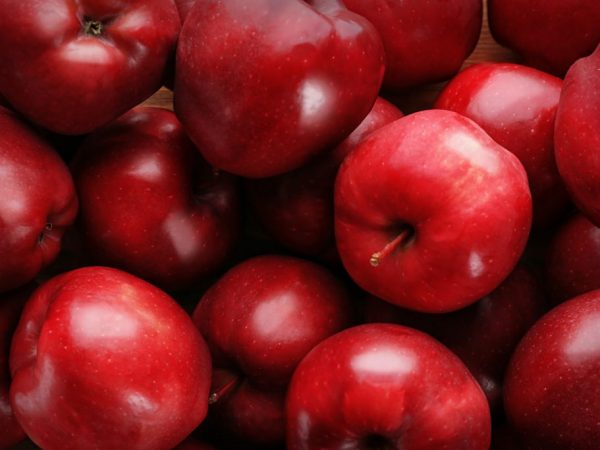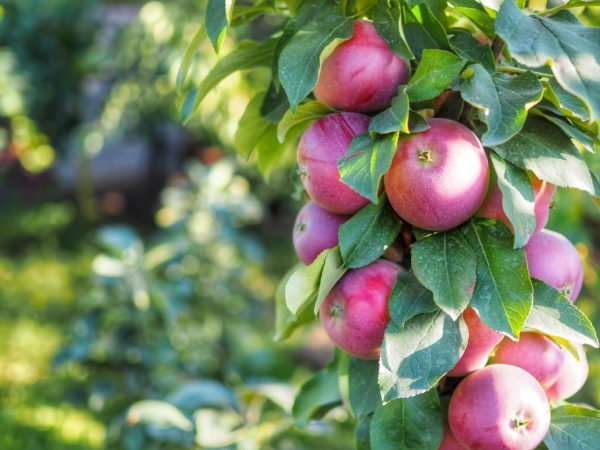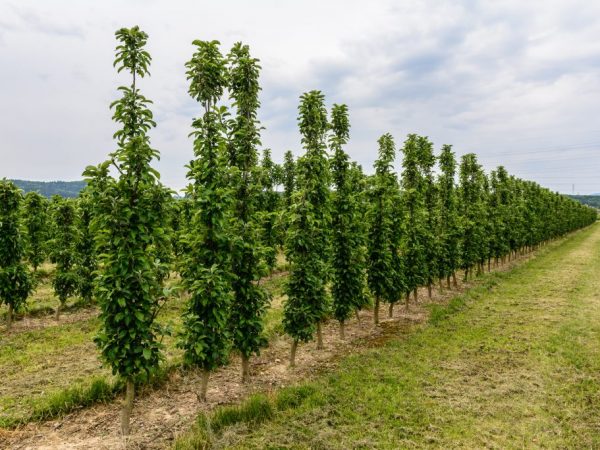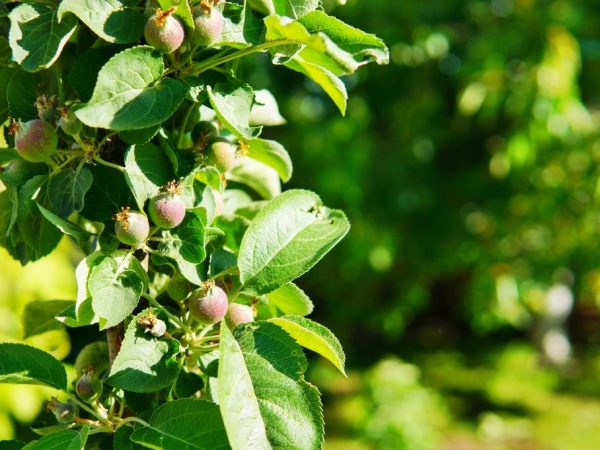Arbat columnar apple variety
One of the most ancient varieties is the Arbat columnar apple tree. It has two important qualities - compact size and high yield. Begins to bear fruit in the first year of planting, which attracts many gardeners.

Arbat columnar apple variety
Features of the variety
The Arbat variety is excellent for growing in the northwestern part of Russia and the Moscow region.
The apple tree can be obtained by seed or grafted onto a dwarf rootstock.
The tree is single-stemmed, practically does not form branches, which greatly facilitates the harvesting procedure. It reaches 3 m in height in industrial gardens, in private gardening a little less - 1.5-2.5 m.
The crown is pyramidal in shape, its circumference is about 20 cm. Fruit ovaries are formed on the central conductor.
The apples are small (120-130 g), round-elongated, dark red, in the context of a creamy shade. The taste is moderately sweet, with a slight sourness and a pronounced aroma.
Advantages and disadvantages
The advantages of the variety:
- compact size, which allows you to grow a tree in a small area - 0.5 m² is enough for one;
- good yield indicators;
- there is resistance to diseases and parasites;
- tolerates low temperatures;
- the plant is self-pollinated.
The description includes several disadvantages - a short shelf life of fruits (3-4 months), without normalization of inflorescences and fruit ovaries, apples become smaller, they do not tolerate transportation well.
Another drawback is the short lifespan of the tree - 15-17 years.
The frequency of fruiting
This variety of columnar apple does not have a fruiting frequency. A small tree spends all the received nutrients for the formation of fruit ovaries, only a small part goes to the development of the aboveground and underground parts.
Fruiting lasts for 15 years.
Yield

The variety has a good yield.
The tree gives its first harvest in the first year of life. From the 5th year, the amount of the crop is about 20 kg.
Apples harvested at the end of August or at the beginning of September are stored until the end of December without losing their taste and marketability.
This variety is characterized by an overload of fruit branches due to increased productivity, therefore, normalization of the fruits is required.
Disease resistance and winter hardiness
With good care and maintenance, this variety rarely gets sick and is affected by pests. But gardeners still recommend preventive measures.
For full-fledged growth, development and high-quality fruiting, the trunk and near-trunk zone are treated with insecticides from parasites - Aktellik, Aktara, Fundazol, Bazudin.
This is done in early spring, along with sanitary pruning.
To prevent the appearance of a viral, bacterial or fungal infection, the crown is treated with a Bordeaux mixture (1%). Sprayed in early spring and late autumn.
Despite the high frost resistance, young and adult trees need good shelter for the winter, because there is a high risk of freezing the top of the central conductor. Under cover, the tree can withstand temperatures as low as -30 °.
Landing rules
Loose, light and fertile soil with a neutral acidity level is suitable for this crop. For landing, they choose a sunny place where there are no winds and underground waters are deeply buried.
For cultivation, you should take strong, healthy seedlings, at least 70 cm long, with a strong root system, without signs of disease and parasites.
The best planting material is one year old or two year old seedlings.
Timing
The ideal time for planting the Arbat variety is early spring, when the snow melts: at this time the buds will not have time to bloom, and this is the most important thing for the successful cultivation of an apple tree.
Some gardeners plant trees in the fall when the buds are fully formed.
Technology

Trees are planted in rows
The optimal planting pattern is 30-40 cm in a row and 1.5-2 m between rows.
At the bottom of the pits, a nutrient composition is poured - a mixture of garden soil, compost (3 kg), superphosphate (50 g), potassium salt (50 g) and wood ash (1 kg). Sprinkle the nutrient composition on top with a thin layer of earth, lay the roots on top, straighten it and sprinkle it with garden soil. For the stability of the seedling, a peg is driven in in the middle of the hole.
When planting, the root collar is left on the surface of the soil. All voids are well covered, and the soil in the near-trunk zone is trampled.
After planting, the plants are watered abundantly with water (3 buckets of water per seedling). Then the near-trunk zone is mulched with peat or last year's manure.
Care features
All care activities begin in early spring, when the last frost has passed.
- During the entire season, trees need to be watered several times: at the initial stage of the growing season, before and after flowering, during the pouring of the fruits and in the fall - after the foliage has fallen off. Under seedlings 1-3 years old, 3-4 buckets of water are poured, starting from the age of five, the amount of water is increased - up to 10 buckets.
- After watering, the soil is loosened to maintain moisture permeability. Weeds are removed as it grows. After each moistening procedure, the near-stem zone is mulched with peat, garden soil or humus. This prevents the soil from drying out and the growth of weeds.
- Normalization of fruit ovaries is a prerequisite for this variety. The procedure is carried out in the summer to avoid overloading the shoots and shrinking the fruit. On annual seedlings, all flower buds are removed so that the plant throws all its strength into the development of the aboveground and underground parts.
- Fertilization is carried out in the 3rd year after planting. Use a solution of chicken manure (1:20) or cow dung (1:10). They are fed in early spring and late autumn. Additionally, superphosphate and potassium salt are added to the soil - 50 g each per bucket of water. Such nutrition is carried out at the beginning of flowering and at the stage of fruit pouring.
- Trimming the crown is necessary purely for sanitary purposes. The procedure is carried out in early spring and autumn - after leaf fall. All organs damaged by frost, winds and diseases are subject to removal. Places of cuts are treated with copper sulfate, then covered with garden var.
- Preparing for winter. In the fall, when the trees have shed their foliage, you can start winter preparation. The tree trunk is treated with slaked lime, wrapped with a metal mesh to protect it from rodents, and sprinkled with a hill of earth, rotted manure or peat. Spruce branches are laid on top. Young trees can be completely covered with roofing felt or cardboard boxes to protect the top of the main conductor from freezing.
Prevention of diseases and pests

Processing will help protect the tree from pests
For parasites (aphids, moths, caterpillars, spider mites), insecticides are used.
The processing of the crown and near-stem zone is carried out in early spring, before flowering and in autumn, after leaf fall.
For diseases (powdery mildew, rust, cytosporosis, gray rot and mosaic), the crown is sprayed with copper-containing preparations at least 2 times - in spring and autumn.
To destroy the larvae, eggs, fungus, wintering in the soil, the near-trunk zone is treated with iron or copper sulfate in spring and autumn.
After spraying, the garden is dug up. It is also important to keep the site clean, remove damaged parts on the tree in time, remove the remnants of vegetation and fallen leaves from the site.
Ripening and fruiting
The harvest of the Arbat columnar apple ripens together, usually in late August - early September. Fruiting is stable and annual, even in adverse weather conditions.
For the storage of fruits, certain conditions are required:
- low air humidity - about 50%;
- temperature within - 1-3 °;
- good ventilation in the room.
In such conditions, apples will remain until the end of December. To prevent premature decay, they are laid in layers in cardboard or wooden boxes, shifting each layer with thick paper. Some put a layer of straw or hay instead of paper.
You can store the harvest on a glazed balcony, loggia, the main thing is that the temperature does not drop to 0 °.
A small amount of apples can be placed in the refrigerator compartment in the fruit and vegetable compartment.
Gardeners reviews
The columnar apple tree Arbat has gained great popularity in both private and industrial gardening.
The description of the culture includes high yield, early fruiting, winter hardiness and unpretentious care.
Also, many are attracted by a tree purely from an aesthetic point of view - it is considered highly decorative, therefore, garden plots are decorated with it.

